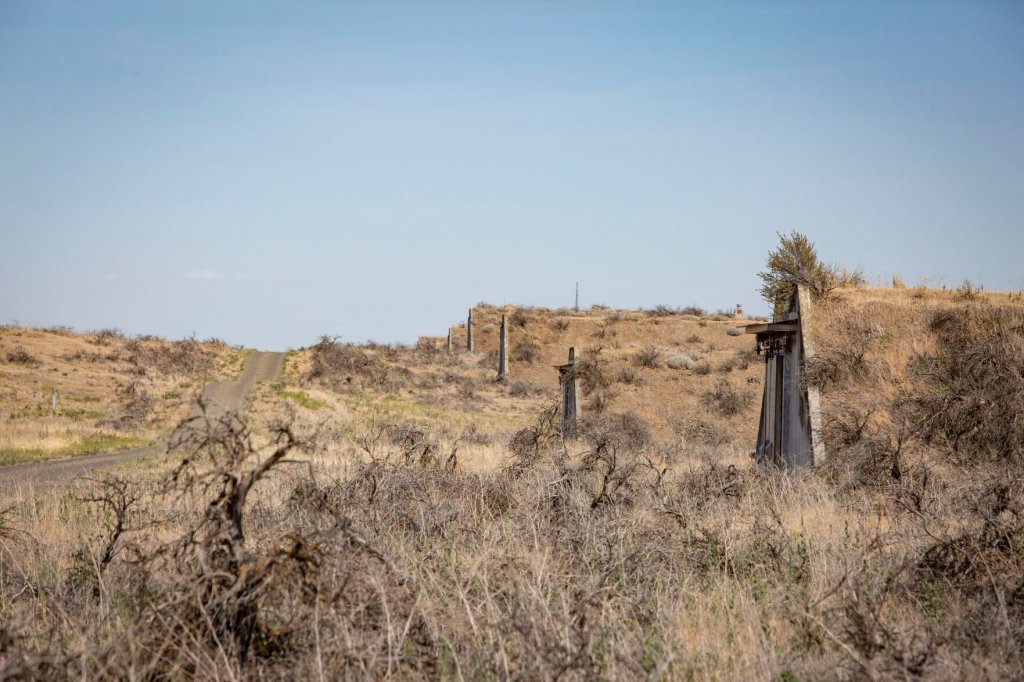U.S. Army transfers former depot land to Columbia Development Authority
Published 1:00 pm Friday, March 31, 2023

- Storage igloos line a section on the southeast corner of the former Umatilla Chemical Weapons Depot on in July 2020. The Army held a ceremony Monday, March 20, 2023, at the Pentagon to recognize transferring the land to the local control of the Columbia Development Authority.
HERMISTON — The former Umatilla Chemical Weapons Depot near Hermiston now is in local control and could be the site of a hydrogen hub for the Northwest.
The U.S. Army on Friday, March 3, transferred the former Umatilla Chemical Weapons Depot land to the Columbia Development Authority in Boardman. The CDA already has slated more than 3,100 acres for industrial development, split between the ports of Morrow and Umatilla. Depot land lies in both counties.
“This is one of the most significant industrial sites in the state of Oregon,” CDA Executive Director Greg Smith said.
He said the transfer represents what can be accomplished when partners come together for a mutually desired outcome. The Army and local officials held a ceremony March 20 at the Pentagon recognizing the transfer of the land to local ownership, a process that has been decades in the making.
Memorializing the deed
Kim Puzey, CDA chair and general manager of the Port of Umatilla, said the signing ceremony “memorialized the fourth largest (real estate transaction) in Base Realignment and Closure history and the largest transfer in 20 years.”
The service had previously handed over 7,500 acres to the Oregon Army National Guard to house its Raymond F. Rees Training Center. Plans call for the CDA eventually to turn the remaining 9,500-plus acres over to its constituent intergovernmental partners, the ports of Umatilla and Morrow, Umatilla and Morrow counties and the Confederated Tribes of the Umatilla Indian Reservation.
Rachel Jacobson, assistant secretary of the Army for Installations, Energy and Environment, hosted the signing event with Lt. Gen. Kevin Vereen, the Army’s deputy chief of staff for Installations.
“The conveyance will place part of the approximately 9,500 acres of property into productive reuse for the community,” Jacobson said. “Another part will become an important cultural site for the beneficial use of the Confederated Tribes of the Umatilla Indian Reservation. A third part will contribute to the historical preservation of the Oregon Trail.”
The proceeds the Army receives from the CDA are to be reinvested into environmental cleanup activities across the Army’s remaining BRAC sites.
“It’s truly a win-win-win outcome for all parties,” Jacobson said.
Vereen said the transfer is the culmination of a 35-year effort starting with realigning the installation under BRAC 1988 and closing the installation under the BRAC 2005 round.
“Umatilla has been a very complex conveyance requiring cooperation and coordination between many local, state and federal organizations and agencies,” he said. “This milestone is a tribute to the many individuals, organizations and agencies that made this day possible.”
Puzey thanked and congratulated all of the local authorities and military partners who have worked on this project. He said the 1991 Strategic Arms Reduction Treaty was essential to ending a generation-long Cold War between the United States and the former Soviet Union.
”The BRAC began the process of returning the former Umatilla Chemical Depot to the Columbia Development Authority,” he said. “Necessary to this end was the incineration or safe transfer of 11% of the entire chemical stockpile of the United States.”
Port of Morrow Executive Director Lisa Mittelsdorf said many visionaries have worked diligently toward this goal.
“This transfer is the culmination of their efforts,” she said. “It is exciting to witness this historic event take place today.”
Kat Brigham, Confederated Tribes of the Umatilla Indian Reservation Board of Trustees chair, joined in the chorus and said now it is time to move forward with planning.
Morrow County Commissioner David Sykes said the completion of this transfer represents new opportunities for the entire region with job creation and enhanced income for counties’ schools and districts.
Umatilla County Commissioner John Shafer described the moment as surreal.
”There have been many great community leaders, including some mentors of mine, who have worked on this,” he said. “To see this finally get across the finish line, and being a part of it, is very exciting.”
The signing came one day before the 79th anniversary of the 1944 Ordnance Depot explosion, Umatilla County Commissioner Cindy Timmons noted.
“(It is) a mystery that has never been solved, and the only fatality incident at the depot during decades of use,” she said. Six people were killed “when 500-pound bombs being unloaded into Igloo B-1014 exploded. A small white cross, and a chunk of concrete, is the only memorial of the event onsite. A fence will be erected around the site for preservation and left as is.”
Industrial development and wildlife habitat
Shafer met with CDA planners March 28. He said businesses are ready to sign leases. One interested industry possibly taking Umatilla County and Oregon into the future is hydrogen hubs.
In cooperation with the CTUIR, the CDA has zoned almost 5,700 acres for wildlife habitat restoration and cultural site protection.
“It was an Uber,” he said. “A Honda Insight. The driver said it was dirt cheap to fill up. It cost $8. But the only places to fill up on the West Coast were in California. If we get a hydrogen hub type company out there, then in that case, we might have the first hydrogen refueling station in Oregon.”
Lake Oswego-based solar energy company Obsidian Renewables applied in November last year to the U.S. Department of Energy to become a green hydrogen hub for the region, producing, storing and transporting the mostly emissions-free gas. An Oregon-Washington partnership, the Pacific Northwest Hydrogen Association, also applied for money to become a Northwest hydrogen hub.
Obsidian’s map showed the depot as its Oregon hub, with another near Moses Lake, Washington.
In cooperation with the CTUIR, the CDA has zoned almost 5,700 acres for wildlife habitat restoration and cultural site protection. More than 600 acres are zoned exclusive farm use.
The Columbia Development Authority is planning a local celebration of the transfer for July.
“There have been many great community leaders, including some mentors of mine, who have worked on this. To see this finally get across the finish line, and being a part of it, is very exciting.”
— Umatilla County Commissioner John Shafer, on the final transfer of Umatilla Chemical Weapon Depot land to local control





